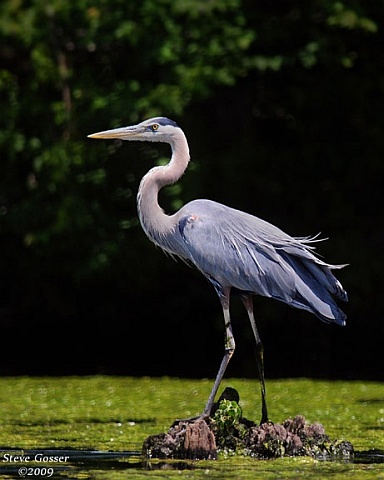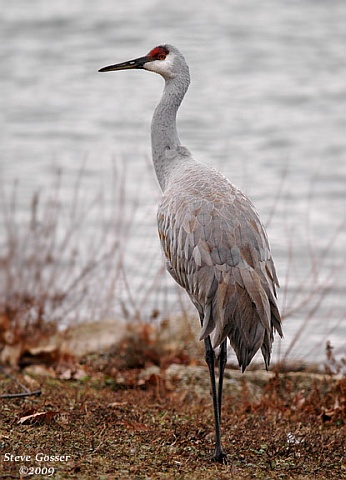When people see a bird that impresses them they often tell me about it. Sometimes they say, “I saw a crane” and I wonder… was it a crane or something else? So I’ve made this conundrum into a quiz.
Which of these are cranes? All of them? Some of them? Only one of them? And which one is non-native?
(The answers are in the comments.)
#1:

#2

#3

#4

(photos #1, #2 and #3 by Steve Gosser, photo #4 from Wikimedia Commons)
p.s. As usual I’ll wait to release comments from moderation so that early responders don’t give away the answer.
Not a bird specialist, but after a quick perusal of Wikipedia I think the birds are:
1. Great Blue Heron (I see this all the time)
2. Great Egret (a type of heron, saw one a month ago in Florida)
3. Hooded Crane?
4. I think this is a crane for loading/unloading barges, but it might be called something else
And, Wikipedia says that Herons are not Cranes, so only 3 & 4 would be Cranes
Mary Ann
Th ed hooded one and you called it is a SANDHILL CRANE ..we have many of them.here in Florida. They are in my ears every day..they mate for life. Babies are cute yellow . We have studied them.for years
Blue Heron, Ibis, Sand Hill Crane..
#1 is a Great Blue Heron! I love the one that stops by the pond in my backyard!
#2 is a crane, but I’m not familiar with the exact name. I saw them on Tangier Island, VA (Chesapeake Bay).
#3 I’m guessing is a crane.
#4 is definitely a crane, possibly at a shipyard?
#1 Great Blue Heron; #2 Great Egret; #3 Sandhill Crane; #4 Construction Crane
I’m taking a stab at this:
1- Great Blue Heron – Year Round in PA
2- Great Egret – Migrates in PA
3- Sandhill Crane – Native to North America, but not PA
4- Crane Machine – used to lift or lower materials – often found in PA
1) great blue heron
2) some kind of egret
3) ?
4) CRANE
great blue heron
great egret
sand hill crane
crane
Barb Wagner & mason4salo have correctly named the species. The first two are herons (not cranes), the last 2 are cranes.
Non-native is a trick question. Think in/out of North America.
p.s. Sandhill cranes nest in western PA. (…oh I’ve given too much away!)
Crane #4 has special talents. It can lift its babies with its “beak.”
See: http://yaymicro.com/stock-image/very-large-crane-lifting-small-crane/4221942
Great quiz, Kate. I knew the Blue Heron. I used to have an office in NY across the street from The Blue Herron Gulf Club, and egrets would walk around my lawn when I lived in Florida.
#4 is the number 1 request by my Grandson to Santa this year, so that one I knew!
Happiest of Holidays to Everyone, whether you celebrate Hanukkah or Christmas, and Blessings for a Happy and Prosperous 2012.
#1 Great Blue Heron
#2 Great Egret
#3 Sandhill Crane (which I have yet to add to my lifelist)
#4 A construction Crane
Darn! I had them right but was late posting due to trying to find the migratory pattern of #4!
Have you ever, or could you in the future post a discussion/comparison of house finch vs purple finch?
so what’s the difference between the two? (herons and cranes) please.
LOL! Kate I loved scrolling down and finding crane #4! You are too funny!
As an extreme novice bird watcher – I wish I could identify the large heron/crane-ish bird I see at North Park Lake on Saturday mornings… if anyone frequents that area and has seen it, can you let me know… thanks
Karen, Crane #4 is non-migratory — a resident of Berlin. He’s the non-native in the bunch.
Amazing ESP! Purple vs. House is in the works & will be on the blog after Christmas.
Kate St. John,
I didn’t know, that Great Egrets are Herons.
I’ve taken some photos of Great Egrets past fall:
http://foto.delfi.lt/picture/2057591/
http://foto.delfi.lt/picture/2057593/
http://foto.delfi.lt/picture/2057433/
I guess, it’s a Little Egret:
http://foto.delfi.lt/picture/2057595/
This is a juvenile Yellow-crowned Night Heron:
http://foto.delfi.lt/picture/2057353/
An adult:
http://foto.delfi.lt/picture/2027513/
Little Egret:
http://foto.delfi.lt/picture/2027519/
>difference between the two? (herons and cranes)
From Wikipedia:
The herons are long-legged freshwater and coastal birds in the family Ardeidae. There are 64 recognised species in this family. Some are called “egrets” or “bitterns” instead of “heron”. … Although herons resemble birds in some other families, such as the storks, ibises, spoonbills and cranes, they differ from these in flying with their necks retracted, not outstretched. They are also one of the bird groups that have powder down (down that purposely disintegrates into powder).
Cranes are a family, Gruidae, of large, long-legged and long-necked birds in the order Gruiformes. There are fifteen species of crane in four genera. Unlike the similar-looking but unrelated herons, cranes fly with necks outstretched, not pulled back.
— From my own perspective: Herons (and egrets and bitterns) always find their food in water and are always found foraging in water. Cranes spend a lot of time on land and will eat land-based foods.
“Herons (and egrets and bitterns) always find their food in water and are always found foraging in water.”
One noted exception I know of is Cattle Egrets. They are usually found in open fields. Even riding on the backs of cattle. They are not common in this area though. I very often see them when I’m in to the Dominican Republic.
ps: I love the Blue Footed Steel Crane by the rivers edge, nice!
Ooooo, yes, Gene. I forgot about cattle egrets! (50 lashes with a wet noodle for me!)
#4 Grus Metallus Nauticalis
For months now I’ve been passing a bird on my way to and from work. At first I thought it was a crane. But something seemed off so I thought maybe a heron. Decided to look up info on the two and after reading an article, thought it had to be the heron. After all, I live in South-Central PA (Franklin County). But then I found this and, really, the bird looks so much more like picture 3 than anything! I never noticed a crook in its neck, but it is also smaller than what I read a crane to be…
Thoughts? Or other things to look for? Sadly, its in a slightly different spot each time I pass by and the road is not exactly suited for stopping for a longer look…
1) great blue heron 2)snowy egret 3) crane 4) crane
LA, at long last I found your message and am replying many months late. In Franklin County PA my guesses are: a great blue heron, a great egret (maybe kind of rare), or a green heron (not pictured). My hunch is “great blue”
1 Great blue crane
2 egret
3 crane
4 looks very much like a pterodactyl.With the long neck and strange shaped head.
Could be wrong about no 4.